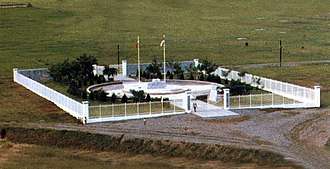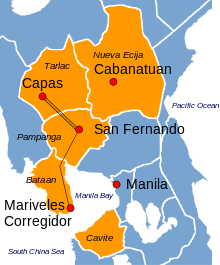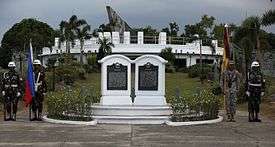Cabanatuan American Memorial

The Camp Pangatian Memorial Shrine or the Cabanatuan American Memorial, formally known as Camp Pangatian, is a World War II memorial located near Cabanatuan City, Philippines. Camp Pangatian was a military training camp for twenty years until it was converted into a concentration camp for allied prisoners of war during the Japanese occupation. The liberation of Camp Pangatian is known as the most successful tactical rescue mission ever executed by the American military. They were aided by Filipino guerrillas who were fighting the invaders. The Raid at Cabanatuan was the result of both the Bataan Death March and Prisoner-of-war camp. Although the Bataan Death March was a significant historical event, the establishment of its memorial in Cabanatuan was not mentioned in any major U.S. news outlets.[1] This tactical operation was immortalized in the movie The Great Raid. The memorial was dedicated on April 12, 1982 by the survivors of the Bataan Death March and the prisoner-of-war camp at Cabanatuan during World War II.[2] The memorial has been maintained by the American Battle Grounds Commission since 1989.[3] Prior to this, it was maintained by the American Battle Monuments Commission.
It is located on the former grounds of the prisoner-of-war camp in honor of those Americans and Filipinos who perished during their internment.[2] The memorial is along the Cabanatuan-Palayan road in Barangay, Pangatian, eight kilometers north of the City Proper.[4]
History

After the surrender of 75,000 Americans by General Edward King Jr. to the Japanese forces during World War II, the American troops were forced to march 65 miles from Mariveles to San Fernando, and then ending in Capas. This is now known as the Bataan Death March. Camp Pangatian is a current memorial site, which was used as a P.O.W. camp for soldiers who were forced to take part in the Bataan Death March.[5] Although this event occurred in 1945, no memorial was made until 1982.
In 1982, the American Battle Monuments Commission wanted to honor those who died in the Bataan Death March. Because of good relationship with the Philippines, the Filipino government allowed construction to begin. President Ronald Reagan signed a joint resolution, on April 6, 1982, which declared that April 12 be officially celebrated as, "American Salute to Cabanatuan Prisoner of War Memorial Day." The unveiling of the Cabanatuan memorial, however, was not of much significance to the Filipino people, as no major newspaper on the island printed any information about the memorial or its dedication.[6]
Appearance
Memorial Wall
Although more than 20,000 U.S. and Allied servicemen and civilians were held in the Japanese internment camp, only 2,656 American names are inscribed on the wall.[2] The names and ranks of the servicemen held in the camp are listed on the memorial walls with horizontal rows with regular Typeface and spacing, similar to the Vietnam Veterans Memorial.[7] A marble altar rests in the center of its 90-square-foot (8.4 m2) concrete base. A large mural of Filipino and American soldiers carrying each other in battle, is present on the roof deck of the memorial.[7] This elevated circular platform is the only place in Nueva Ecija where the Filipino flag stands side by side next to the American flag.[8]
The dedication, which is located on the back of the Cabanatuan sign, describes the memorial. It reads, "SITE OF THE JAPANESE PRISONER OF WAR CAMP 1942 TO 1945 THIS MEMORIAL HONORS THE AMERICAN SERVICEMEN AND THE CIVILIANS WHO DIED HERE AND GRATEFULLY ACKNOWLEDGES THE EQUALLY HEROIC SACRIFICES MADE BY FILIPINO SERVICEMEN AND CIVILIANS IN A MUTUAL QUEST FOR HONOR, FREEDOM AND PEACE IT ALSO REMINDS MANKIND OF MAN’S INHUMANITY TO HIS FELLOWMAN. ERECTED AND DEDICATED 12 APRIL 1982 BY AMERICAN AND FILIPINO COMRADES, FAMILIES AND FRIENDS."[3]

Addition
On April 6, 2003, the provincial government inaugurated a second memorial on a piece of land adjacent to the U.S.-maintained memorial.[8] The original monument honors the heroism of the American prisoners of war in Pangatian. The second memorial, however, pays a tribute to the Filipino guerrillas who helped in the liberation of Camp Pangatian.[8] The addition features a circular platform with two tablets from the National Historical Institute. One of these platforms is in Filipino while the other is in English. The tablets read, "ON THE NIGHT OF JANUARY 30, 1945, FILIPINO GUERRILLAS UNDER CAPTAINS JUAN PAJOTA AND EDUARDO JOSON EFFECTIVELY PREVENTED JAPANESE REINFORCEMENTS AT PANGATIAN CONCENTRATION CAMP IN CABANATUAN. THE BATTLE OF CABU BRIDGE AND THE BLOCKADE AT BANGDAD RESULTED IN THE LIBERATION OF 516 ALLIED PRISONERS OF WAR. THE JOINT OPERATION OF THE GUERRILLAS, ALAMO SCOUTS, AND THE U.S. 6TH RANGER BATTALION WAS UNDER LT. COL. HENRY MUCCI. THIS EVENT ONE OF THE SUCCESSFUL RESCUE MISSIONS OF ITS TYPE IN THE ANNALS OF U.S. MILITARY HISTORY."
References
- ↑ "Log in to NewsBank". infoweb.newsbank.com. Retrieved 2016-12-17.
- 1 2 3 "Cabanatuan American Memorial | American Battle Monuments Commission". www.abmc.gov. Retrieved 2016-12-10.
- 1 2 "Memorial POW-camp Cabanatuan - Cabanatuan City - TracesOfWar.com". en.tracesofwar.com. Retrieved 2016-12-14.
- ↑ Valmonte, Ramon. "Pangatian War Memorial". monvalmonte.com. Retrieved 2016-12-14.
- ↑ "Bataan Death March - World War II - HISTORY.com". HISTORY.com. Retrieved 2016-12-14.
- ↑ "Text of H.J.Res. 435 (97th): A joint resolution providing for the designation of April 12, 1982, as "American ... (Passed Congress/Enrolled Bill version) - GovTrack.us". GovTrack.us. Retrieved 2016-12-16.
- 1 2 Visitmyphilippines.com. "Department of Tourism - The Philippines Ultimate Travel Guide for Tourist". www.visitmyphilippines.com. Retrieved 2016-12-18.
- 1 2 3 Valmonte, Ramon. "Pangatian War Memorial". monvalmonte.com. Retrieved 2016-12-16.
Coordinates: 15°30′34″N 121°02′40″E / 15.50955°N 121.04456°E